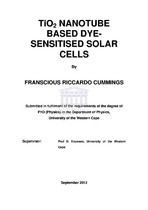| dc.description.abstract | This work investigated the synthesis of Al2O3-coated TiO2 nanotubes via the anodisation technique for application in DSCs. TiO2 nanotube arrays with
an average length of 15 μm, diameter of 50 nm and wall thickness of 15 nm
were synthesised via anodisation using an organic neutral electrolyte consisting
of 2 M H2O + 0.15 M NH4F + ethylene glycol (EG) at an applied voltage of 60 V
for 6 hours. In addition, scanning electron microscope (SEM) micrographs
showed that anodisation at these conditions yields nanotubes with smooth
walls and hexagonally shaped, closed bottoms. X-ray diffraction (XRD) patterns revealed that the as-anodised nanotubes were amorphous and as such were annealed at 450 °C for 2 hours in air at atmospheric pressure, which yielded crystalline anatase TiO2 nanotubes. Highresolution transmission electron microscope (TEM) images revealed that the nanotube walls comprised of individual nano-sized TiO2 crystallites.
Photoluminescence (PL) spectroscopy showed that the optical properties, especially the bandgap of the TiO2 nanotubes are dependent on the crystallinity, which in turn was dependent on the structural characteristics, such as the wall thickness, diameter and length. The PL measurements were supplemented by Raman spectra, which revealed an increased in the quantum confinement of the optical phonon modes of the nanotubes synthesised at low anodisation voltages, consequently yielding a larger bandgap
The annealed nanotubes were then coated with a thin layer of alumina (Al2O3) using a simple sol-gel dip coating method, effectively used to coat films of nanoparticles. Atomic force microscopy (AFM) showed that the average nanotube diameter increased post sol-gel deposition, which suggests that the nanotubes are coated with a layer of Al2O3. This was confirmed with HR-TEM, in conjunction with selected area electron diffraction (SAED) and XRD analyses, which showed the coating of the nanotube walls with a thin layer of amorphous Al2O3 with a thickness between 4 and 7 nm. Ultraviolet-visible (UVvis) absorbance spectra showed that the dye-adsorption ability of the nanotubes are enhanced by the Al2O3 coating and hence is a viable material for
solar cell application. Upon application in the DSC, it was found by means of photo-current density – voltage (I – V) measurements that a DSC fabricated with a 15 μm
thick layer of bare TiO2 nanotubes has a photon-to-light conversion efficiency of
4.56%, which increased to 4.88% after coating the nanotubes with a layer of
alumina. However, these devices had poorer conversion efficiencies than bare
and Al2O3-coated TiO2 nanoparticle based DSCs, which boasted with efficiencies of 6.54 and 7.26%, respectively. The low efficiencies of the TiO2 nanotube based DSCs are ascribed to the low surface area of the layer of nanotubes, which yielded low photocurrent densities. Electrochemical impedance spectroscopy (EIS) showed that the electron lifetime in the alumina coated nanotubes are almost 20 times greater than in a bare layer of nanoparticles. In addition, it was also found that the charge transfer resistance at the interface of the TiO2/dye/electrolyte is the lowest for an Al2O3-coated TiO2 layer. | en_US |

